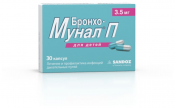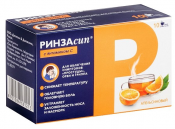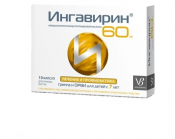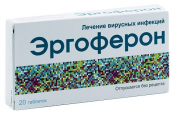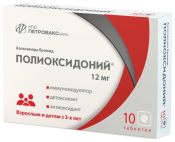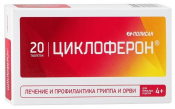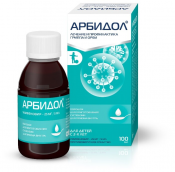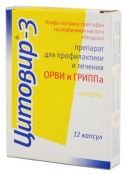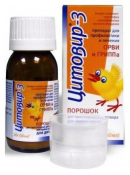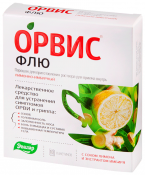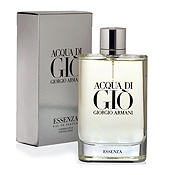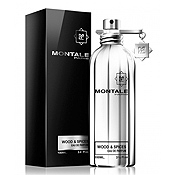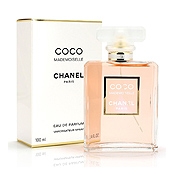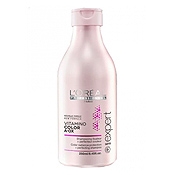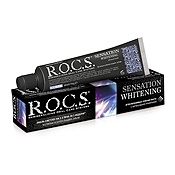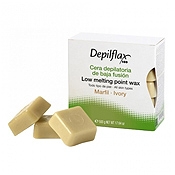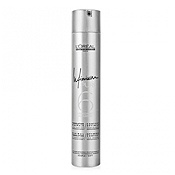Natur Product Pharma Antigrippin for children tab. spike. No. 30
Short review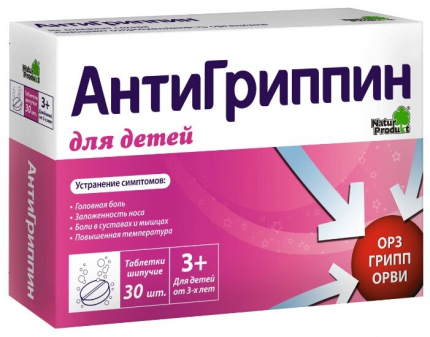
Selected in the rating
16
Best rating
antiviral drugs
For children - For ARVI - For colds - Tablets / capsules
Buy Natur Product Pharma Antigrippin for children tab. spike. No. 30
Characteristics of Natur Product Pharma Antigrippin for children tab. spike. No. 30
Yandex.Market data
| General characteristics | |
| Drug type | medicinal product |
| Appointment | symptomatic treatment of colds, flu, ARVI |
| Indications for use | Infectious and inflammatory diseases (ARVI, flu), accompanied by fever, chills, headache, pain in the joints and muscles, nasal congestion and pain in the throat and sinuses. |
| Contraindications | - hypersensitivity to paracetamol, ascorbic acid, chlorphenamine or any other component of the drug; - erosive and ulcerative lesions of the gastrointestinal tract (in the acute phase); - severe renal and / or hepatic failure; - angle-closure glaucoma; - children's age (up to 3 years). |
| Structure | Active ingredient: paracetamol - 250 mg; chlorphenamine maleate - 3 mg; ascorbic acid - 50 mg Excipients: sodium bicarbonate - 740 mg, citric acid - 830 mg, sorbitol - 745.5 mg, povidone - 12.5 mg, sodium saccharinate - 30 mg, sodium carbonate - 100 mg, macrogol - 90 mg, silicon dioxide - 9 mg, fruit flavor (aromatic fruit additive "Red fruits") - 140 mg. |
| Active substance | Paracetamol + Chlorphenamine + Ascorbic acid |
| Method of administration and dosage | Inside. Children from 3 to 5 years old take 1/2 tablet 2 times a day; children from 5 to 10 years old, 1 tablet 2 times a day; children from 10 to 15 years old no 1 tablet 2-3 times a day. The tablet should be completely dissolved in a glass (200 ml) of warm water (50-60 ° C) and the resulting solution should be drunk immediately. Better to take the drug in between doses of poverty. The interval between doses of the drug should be at least 4 hours. In patients with impaired liver or kidney function, the interval between doses of the drug should be at least 8 hours. Duration of admission without consulting a doctor is no more than 5 days when prescribed as an anesthetic and 3 days as an antipyretic agent. |
| Side effects | The drug is well tolerated in the recommended doses. In isolated cases, there are: From the side of the central nervous system: headache, fatigue; From the gastrointestinal tract: nausea, pain in the epigastric region; From the endocrine system: hypoglycemia (up to the development of coma); From the side of hematopoietic organs: anemia, hemolytic anemia (especially for patients with deficiency of glucose-6-phosphate dehydrogeiaase); extremely rare - thrombocytopenia; Allergic reactions: skin rash, itching, urticaria, Quincke's edema. Others: hypervntaminosis, metabolic disorders, feeling of heat, dry mouth, accommodation paresis, urinary retention, drowsiness. All side effects of the drug should be reported to your doctor. |
| pharmachologic effect | Combined drug. Paracetamol has analgesic and antipyretic effects; eliminates headaches and other types of pain, reduces fever. Ascorbic acid (vitamin C) is involved in the regulation of redox processes, carbohydrate metabolism, and increases the body's resistance. Chlorphenamine - a blocker of H1-histamine receptors, has an anti-allergic effect, facilitates breathing through the nose, reduces nasal congestion, sneezing, watery eyes, itching and redness of the eyes. |
| Pharmacological group | ARI and "cold" symptoms remedy (analgesic non-narcotic drug + H1-histamine receptor blocker + vitamin) |
| Release form | effervescent tablets |
| Method of application / administration | oral |
| Minimum age of use | from 3 years |
| Additionally | |
| Storage conditions | At a temperature of 10-30 ° C, in a dry, dark place. Keep out of the reach of children. The shelf life is 3 years. |
| Overdose | Symptoms of an overdose of the drug are due to its constituent substances. The clinical picture of an acute overdose of paracetamol develops within 6-14 hours after taking it. Symptoms of chronic overdose appear 2-4 days after increasing the dose of the drug. Symptoms of acute paracetamol overdose: diarrhea, decreased appetite, nausea and vomiting, abdominal discomfort and / or abdominal pain, increased sweating. Chlorphenamine overdose symptoms: dizziness, agitation, sleep disturbances, depression, convulsions. Treatment: symptomatic. |
| special instructions | If you are taking metoclopramide, domperidone, or cholestyramine, you should also consult your doctor. With prolonged use in doses significantly higher than recommended, the likelihood of impaired liver and kidney function increases; control of the peripheral blood picture is necessary. Paracetamol and ascorbic acid can distort laboratory tests (quantitative determination of glucose and uric acid in blood plasma, bilirubin, activity of "hepatic" transaminases, LDH). The administration of ascorbic acid to patients with rapidly proliferating and intensely metastatic tumors can aggravate the process. In patients with an increased iron content in the body, ascorbic acid should be used in minimal doses. With care: renal and / or hepatic failure, glucose-6-phosphate dehydrogenase deficiency, congenital hyperbilirubinemia (Gilbert, Dubin-Johnson and Rotor syndromes), viral hepatitis. |
| Interaction | Ethanol enhances the sedative effect of antihistamines. Antidepressants, antiparkinsonian drugs, antipsychotics (phenothiazine derivatives) - increase the risk of side effects (urinary retention, dry mouth, constipation). Glucocorticosteroids - increase the risk of developing glaucoma. With simultaneous use, it reduces the chronotropic effect of isoprenaline. Reduces the therapeutic effect of antipsychotic drugs (neuroleptics) - phenothiazine derivatives, tubular reabsorption of amphetamine and tricyclic antidepressants. Inducers of microsomal oxidation in the liver (phenytoin, ethanol, barbiturates, rifampicin, phenylbutazone, tricyclic antidepressants) increase the production of hydroxylated active metabolites, which makes it possible to develop severe intoxication with small overdoses. Ethanol contributes to the development of acute pancreatitis. Inhibitors of microsomal oxidation (including cimetidine) reduce the risk of hepatotoxic effects. Simultaneous administration of the drug and diflunisal increases the concentration of paracetamol in the blood plasma by 50%, and increases hepatotoxicity. Simultaneous reception of barbiturates reduces the effectiveness of paracetamol, increases the excretion of ascorbic acid in the urine. Paracetamol reduces the effectiveness of uricosuric drugs. |
| Registration number | P N015187 / 02 |
| Date of state registration | 2010/03/01 00:00:00 |
| Marketing Authorization Holder | Valeantes |
| Brand country | Russia |
| Manufacturer country | Poland |
| Drug name | Antigrippin |
Reviews of Natur Product Pharma Antigrippin for children tab. spike. No. 30
Yandex.Market data
Advantages:
Effective and delicious!
Disadvantages:
None found!
Comment:
Mothers definitely need to take note of Antigrippin from Natur Product, the temperature drops by one or two, it helped my child really quickly. Therefore, I will be at home and at the dacha to store this in the first-aid kit, you yourself understand that there are different cases. And if there is not one child in the family, but three, like ours, so in general you must always be on alert))
April 10, 2020, Zhukovsky
Awesome and tastes good
8 July 2014
Advantages: They help to recover well Disadvantages: Not autumn pleasant taste Good shipulin tablets
December 24, 2013

